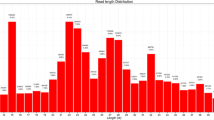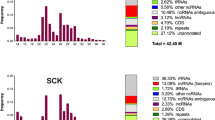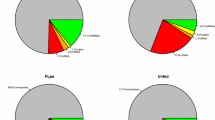Abstract
MicroRNAs (miRNAs) are small, noncoding RNAs that play key roles in regulating gene expression in animals, plants, and viruses, which involves in biological processes including development, cancer, immunity, and host–microorganism interactions. In this present study, we have used the computational approach to identify potent miRNAs involved in Anopheles gambiae immune response. Analysis of 217,261 A. gambiae ESTs and further study of RNA folding revealed six new miRNAs. The minimum free energy of the predicted miRNAs ranged from −27.2 to −62.63 kcal/mol with an average of −49.38 kcal/mol. While its A + U % ranges from 50 to 65 % with an average value of 57.37 %. Phylogenetic analysis of the predicted miRNAs revealed that aga-miR-277 was evolutionary highly conserved with more similarity with other mosquito species. Observing further the target identification of the predicted miRNA, it was noticed that the aga-miR-2304 and aga-miR-2390 are involved in modulation of immune response by targeting the gene encoding suppressin and protein prophenoloxidase. Further detailed studies of these miRNAs will help in revealing its function in modulation of A. gambiae immune response with respect to its parasite.



Similar content being viewed by others
References
Reinhart, B. J., Weinstein, E. G., Rhoades, M. W., Bartel, B., & Bartel, D. P. (2002). MicroRNAs in plants. Genes and Development, 16(13), 1616–1626.
Bartel, D. P. (2004). MicroRNAs: genomics, biogenesis, mechanism, and function. Cell, 116, 281–297.
Lee, Y., Jeon, K., Lee, J. T., Kim, S., & Kim, V. N. (2002). MicroRNA maturation: stepwise processing and subcellular. EMBO Journal, 21(17), 4663–4670.
Lee, Y., Ahn, C., Han, J., Choi, H., Kim, J., Yim, J., et al. (2003). The nuclear RNase III Drosha initiates microRNA processing. Nature, 425(6956), 415–419.
Hammond, S. C., Bernstein, E., Beach, D., & Hannon, G. J. (2000). An RNA-directed nuclease mediates post-transcriptional gene silencing in drosophila cells. Nature, 404(6775), 293–296.
Ambros, V., & Lee, R. C. (2004). Identification of microRNAs and other tiny noncoding RNAs by cDNA cloning. Methods Mol Biol, 265, 131–158.
Berezikov, E., Cuppen, E., & Plasterk, R. H. (2006). Approaches to microRNA discovery. Nat Genet, 38, S2–S7.
Xie, J., Techritz, S., Haebel, S., Horn, A., Neitzel, H., Klose, J., et al. (2005). A two-dimensional electrophoretic map of human mitochondrial proteins from immortalized lymphoblastoid cell lines: a prerequisite to study mitochondrial disorders in patients. Proteomics, 5(11), 2981–2999.
Manguin, S., Bangs, M. J., Pothikasikorn, J., & Chareonviriyaphap, T. (2010). Review on global co-transmission of human Plasmodium species and Wuchereria bancrofti by Anopheles mosquitoes. Infection, Genetics and Evolution, 10(2), 159–177.
Lee, R. C., Feinbaum, R. L., & Ambros, V. (1993). The C. elegans heterochronic gene lin-4 encodes small RNAs with antisense complementarity to lin-14. Cell, 75(5), 843–854.
Holt, R. A., Subramanian, G. M., Halpern, A., Sutton, G. G., Charlab, R., Nusskern, D. R., et al. (2002). The genome sequence of the malaria mosquito Anopheles gambiae. Science, 298(5591), 129–149.
Cameron, J. E., Yin, Q., Fewell, C., Lacey, M., Mcbride, J., Wang, X., et al. (2008). The Epsteinn–Barr virus latent membrane protein 1 (LMP1) induces cellular miRNA-146a, a modulator of lymphocyte signaling pathways. Journal of Virology, 82(4), 1946–1958.
Pedersen, I. M., Cheng, G., Wieland, S., Volinia, S., Croce, C. M., Chisari, F. V., et al. (2007). Interferon modulation of cellular microRNAs as an antiviral mechanism. Nature, 449(7164), 919–922.
Xiao, C., & Rajewsky, K. (2009). MicroRNA control in the immune system: basic principles. Cell, 136(1), 26–36.
Lei, X., Bai, Z., Ye, F., Xie, J., Kim, C. G., Huang, Y., et al. (2010). Regulation of NF-kappaB inhibitor IkappaBalpha and viral replication by a KSHV microRNA. Nat Cell Biol, 12(2), 193–199.
Zeiner, G. M., Norman, K. L., Thomson, J. M., Hammond, S. M., & Boothroyd, J. C. (2010). Toxoplasma gondii infection specifically increases the levels of key host microRNAs. PLoS ONE, 5(1), e8742.
Altschul, S. F., Gish, W., Miller, W., Myers, E. W., & Lipman, D. J. (1990). Basic local alignment search tool. J Mol Biol, 215(3), 403–410.
Thompson, J. D., Higgins, D. G., & Gibson, T. J. (1994). CLUSTAL W: improving the sensitivity of progressive multiple sequence alignment through sequence weighting, position-specific gap penalties, and weight matrix choice. Nucleic Acids Res, 22(22), 4673–4680.
Altschul, S. F., Madden, T. L., Schäffer, A. A., Zhang, J., Zhang, Z., Miller, W., et al. (1997). Gapped BLAST and PSI-BLAST: a new generation of protein database search programs. Nucleic Acids Res, 25(17), 3389–3402.
Zhang, B., Pan, X., & Anderson, T. A. (2006). Identification of 188 conserved maize microRNAs and their targets. FEBS Lett, 580(15), 3753–3762.
Griffiths-Jones, S., Bateman, A., Marshall, M., Khanna, A., & Eddy, S. R. (2003). Rfam: an RNA family database. Nucleic Acids Res, 31(1), 439–441.
Tamura, K., Dudley, J., Nei, M., & Kumar, S. (2007). MEGA4: Molecular Evolutionary Genetics Analysis (MEGA) software version 4.0. Mol Biol Evol, 24(8), 1596–1599.
Tamura, K., Nei, M., & Kumar, S. (2004). Prospects for inferring very large phylogenies by using the neighbor-joining method. Proc Natl Acad Sci USA, 101(30), 11030–11035.
Chen, S., Zhang, A., Blyn, L. B., & Storz, G. (2004). MicC, a second small-RNA regulator of Omp protein expression in Escherichia coli. J Bacteriol, 186(20), 6689–6697.
Esau, C., Kang, X. L., Peralta, E., Hanson, E., Marcusson, E. G., Ravichandran, L. V., et al. (2004). MicroRNA-143 regulates adipocyte differentiation. J Biol Chem, 279(50), 52361–52365.
Zhao, F., Xuan, Z., Liu, L., & Zhang, M. Q. (2005). TRED: a transcriptional regulatory element database and a platform for in silico gene regulation studies. Nucleic Acids Res, 33, D103–D107.
Poy, M. N., Eliasson, L., Krutzfeldt, J., Kuwajima, S., Ma, X., Macdonald, P. E., et al. (2004). A pancreatic islet-specific microRNA regulates insulin secretion. Nature, 432(7014), 226–230.
Lecellier, C., Dunoyer, P., Arar, K., Lehmann-Che, J., Eyquem, S., Himber, C., et al. (2005). A cellular microRNA mediates antiviral defense in human cells. Science, 308(5721), 557–560.
Martello, G., Rosato, A., Ferrari, F., Manfrin, A., Cordenonsi, M., Dupont, S., et al. (2010). A microRNA targeting dicer for metastasis control. Cell, 141(7), 1195–1207.
Chatterjee, R., & Chaudhuri, K. (2006). An approach for the identification of microRNA with an application to Anopheles gambiae. Acta Biochim Pol, 53(2), 303–309.
Hackl, M., Jadhav, V., Jakobi, T., Rupp, O., Brinkrolf, K., Goesmann, A., et al. (2012). Computational identification of microRNA gene loci and precursor microRNA sequences in CHO cell lines. J Biotechnol, 158(3), 151–155.
Mead, E. A., & Tu, Z. (2008). Cloning, characterization, and expression of microRNAs from the Asian malaria mosquito, Anopheles stephensi. BMC Genomics, 9, 244. doi:10.1186/1471-2164-9-244.
Hussain, M., Frentiu, F. D., Moreira, L. A., O’Neill, S. L., & Asgari, S. (2011). Wolbachia uses host microRNAs to manipulate host gene expression and facilitate colonization of the dengue vector Aedes aegypti. Proc Natl Acad Sci USA, 108(22), 9250–9255.
Winter, F., Edaye, S., Huttenhofer, A., & Brunel, C. (2007). Anopheles gambiae miRNAs as actors of defense reaction against Plasmodium invasion. Nucleic Acids Res, 35(20), 6953–6962.
Skalsky, R., Vanlandingham, D. L., Scholle, F., Higgs, S., & Cullen, B. R. (2010). Identification of microRNAs expressed in two mosquito vectors, Aedes albopictus and Culex quinquefasciatus. BMC Genomics, 11, 119. doi:10.1186/1471-2164-11-119.
Acknowledgments
All the authors are thankful to the Pondicherry Centre for Biological centre (PCBS) for providing the necessary facility to carry out the work. Financial support as startup loan from State Bank of India (RASMECC), Pondicherry, India to establish the institute is also gratefully acknowledged.
Author information
Authors and Affiliations
Corresponding author
Rights and permissions
About this article
Cite this article
Thirugnanasambantham, K., Hairul-Islam, V.I., Saravanan, S. et al. Computational Approach for Identification of Anopheles gambiae miRNA Involved in Modulation of Host Immune Response. Appl Biochem Biotechnol 170, 281–291 (2013). https://doi.org/10.1007/s12010-013-0183-5
Received:
Accepted:
Published:
Issue Date:
DOI: https://doi.org/10.1007/s12010-013-0183-5




